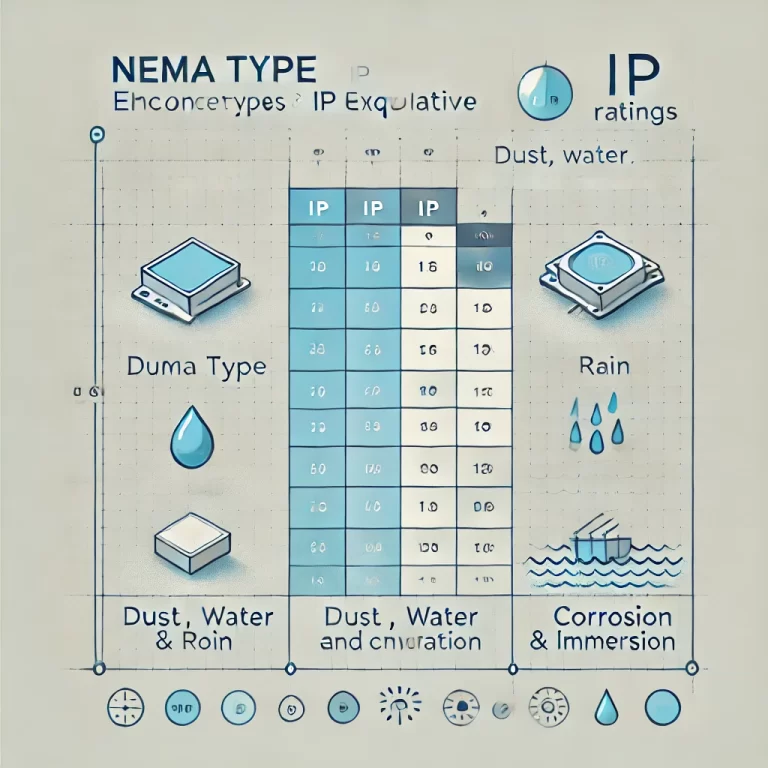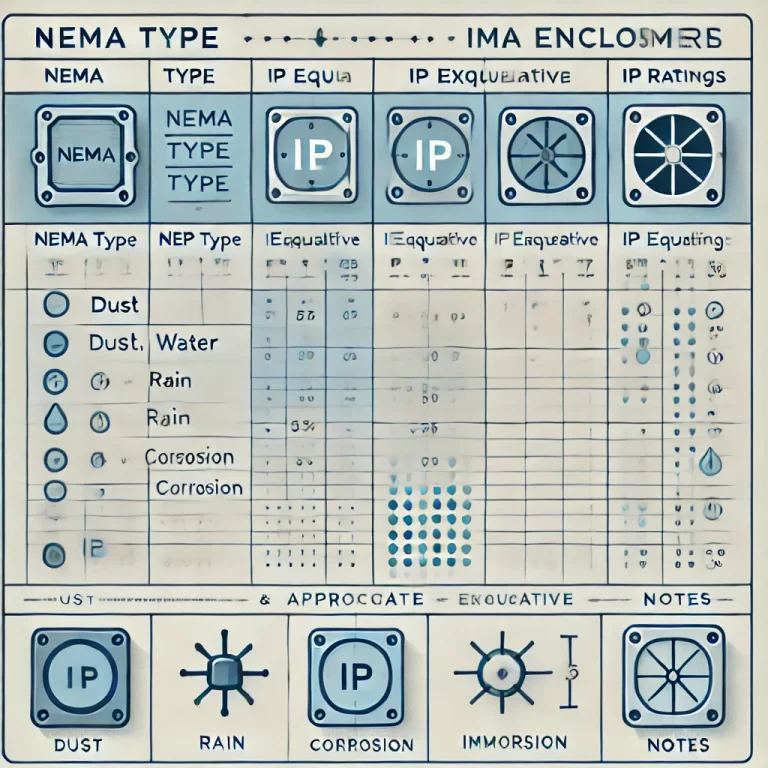In industrial and commercial environments, the protection of electrical equipment against environmental hazards is critical. To address this need, the National Electrical Manufacturers Association (NEMA) established a set of standards that define the performance requirements for electrical enclosures. These NEMA enclosure type standards specify the degree of protection an enclosure provides against dust, water, oil, corrosion, and external mechanical impacts.
This article provides a detailed overview of the NEMA enclosure types, their applications, and the key differences compared to international IP ratings.
1. What Are NEMA Enclosure Standards?
The NEMA enclosure standards categorize enclosures based on their ability to protect internal components from environmental influences. Each type addresses different operating conditions, such as indoor dust exposure, outdoor rain, snow, corrosive atmospheres, or hazardous locations involving explosive gases or dust.
Unlike the IEC’s IP rating system, NEMA standards not only consider water and dust ingress but also account for factors like corrosion resistance, construction robustness, and even operational functionality under ice formation.
2. Summary of Common NEMA Enclosure Types
| NEMA Type | Protection Provided | Typical Applications |
|---|---|---|
| Type 1 | Indoor use; protects against light dust and accidental contact | Offices, indoor machinery |
| Type 2 | Indoor use; protects against dripping water and dust | Laundry rooms, boiler rooms |
| Type 3 | Outdoor use; protects against rain, sleet, snow, and dust | Outdoor control panels |
| Type 3R | Outdoor use; protects against rain and ice; limited dust protection | Meter boxes, simple outdoor enclosures |
| Type 3S | Same as Type 3, but with operable mechanisms even under ice | Severe weather outdoor controls |
| Type 4 | Indoor or outdoor use; protects against windblown dust, rain, splashing water, and hose-directed water | Wash-down areas, industrial plants |
| Type 4X | Same as Type 4, with added corrosion resistance | Marine environments, food processing |
| Type 5 | Indoor use; protects against dust, lint, fibers | Textile manufacturing, clean rooms |
| Type 6 | Protects against occasional submersion in water | Temporary flood-prone areas |
| Type 6P | Protects against prolonged submersion and corrosion | Underground or submerged applications |
| Type 7 | Indoor use in hazardous locations (Class I, Division 1 – explosive gases) | Chemical plants, oil refineries |
| Type 8 | Indoor or outdoor hazardous locations; immersion in oil environment (Class I, Division 1) | Oil and gas fields |
| Type 9 | Indoor hazardous locations with combustible dust (Class II, Division 1) | Flour mills, grain elevators |
| Type 10 | Special design for mining equipment (MSHA compliance) | Underground mining operations |
| Type 11 | Protection against corrosion, oil, and coolant seepage | Chemical and food plants |
| Type 12 | Indoor use; protects against dust, dripping liquids, and non-corrosive fluids | Manufacturing plants, packaging areas |
| Type 12K | Same as Type 12 but with pre-punched knockouts | Assembly line panels |
| Type 13 | Indoor use; protects against dust, spraying water, and non-corrosive oils | Industrial machinery and maintenance rooms |
3. Key Differences Between NEMA and IP Ratings
While NEMA and IP (Ingress Protection) ratings both describe environmental protection, there are significant differences:
NEMA ratings include protection against corrosion, icing, and operational functionality under abnormal conditions.
IP ratings mainly focus on protection against solid objects and water penetration only.
For example:
NEMA Type 4 roughly corresponds to IP66 (dust-tight and protected against powerful water jets),
NEMA Type 6 approximates IP67 (dust-tight and protected against immersion).
However, they are not directly interchangeable, and engineers must review specifications carefully when substituting standards across international projects.

4. How to Choose the Right NEMA Enclosure
When selecting a NEMA enclosure, consider the following factors:
Location: Indoor or outdoor installation?
Environmental Hazards: Dust, water, chemicals, explosive gases, or combustible dust?
Operation Requirements: Will the equipment operate under snow, rain, or submerged conditions?
Material Needs: Is corrosion resistance necessary? (e.g., marine-grade stainless steel for coastal installations)
Compliance Requirements: Are MSHA, NEC, or OSHA certifications needed?
Selecting the correct NEMA enclosure ensures not only the protection of critical equipment but also long-term reliability, regulatory compliance, and operational safety.
5. NEMA vs. IP Rating Comparison Table
Here is a simplified comparison table to help you understand the approximate relationships between NEMA enclosure types and IP (Ingress Protection) codes:
| NEMA Type | Approximate IP Equivalent | Notes |
|---|---|---|
| Type 1 | IP10 | Protection against light dust; indoor use |
| Type 2 | IP11 | Protection against dripping water and dust |
| Type 3 | IP54 | Dust-protected, rain-resistant; outdoor use |
| Type 3R | IP24 | Rain-resistant but limited dust protection |
| Type 4 | IP66 | Dust-tight and protected against strong water jets |
| Type 4X | IP66 | Same as Type 4 + corrosion resistance |
| Type 5 | IP52 | Dust-protected, limited protection against dripping |
| Type 6 | IP67 | Dust-tight and protected against temporary immersion |
| Type 6P | IP68 | Dust-tight and protected against prolonged immersion |
| Type 12/12K | IP52 | Dust-protected and dripping liquid-resistant |
| Type 13 | IP54 | Dust-protected, splash-resistant |
⚡ Important Note:
NEMA ratings often include additional considerations like corrosion resistance, construction strength, and operation under ice — which are not fully addressed by IP codes.
6. How to Select a NEMA Enclosure: Step-by-Step Flow Chart
Here’s a practical flow you can follow when selecting the right NEMA enclosure for a project:
➊ Identify Installation Environment
Indoor → Consider Types 1, 2, 12, 13
Outdoor → Consider Types 3, 3R, 4, 4X, 6, 6P
➋ Assess Environmental Hazards
Dust → Types 5, 12, 13
Dripping Water → Types 2, 12, 13
Rain/Snow → Types 3, 3R, 4, 4X
Wash-down (high-pressure water) → Types 4, 4X
Corrosive Atmosphere → Type 4X, 11
➌ Determine Risk of Immersion
Occasional Submersion → Type 6
Prolonged Submersion → Type 6P
➍ Check for Hazardous Locations
Explosive Gases → Type 7, 8
Combustible Dust → Type 9
➎ Confirm Special Requirements
Need for Corrosion Resistance → Type 4X, 11
MSHA Mining Approval → Type 10
➏ Finalize Material and Design
Standard steel, stainless steel, aluminum, or fiberglass depending on corrosion risk and mechanical strength needed.

Visual Representation (Text Version)
[Indoor?] ─▶ [Yes] ─▶ [Type 1, 2, 12, 13]
└─▶ [Drip? Dust? Oil? Choose based on conditions]
[Outdoor?] ─▶ [Yes] ─▶ [Type 3, 3R, 4, 4X, 6, 6P]
└─▶ [Rain only? (3R) | Rain+Dust? (3, 4, 4X)]
[Submersion? (6, 6P)]
[Corrosion? (4X)]
[Hazardous?] ─▶ [Yes] ─▶ [Explosive Gas? (7, 8) | Dust? (9)]
Final Tips
Don’t Over-Specify: Higher protection ratings often increase cost unnecessarily if not needed.
Local Regulations Matter: Check if local codes require minimum NEMA types (e.g., NEC, OSHA).
Maintenance Access: Ensure the selected enclosure type supports easy inspection and service if needed.
